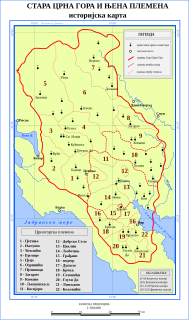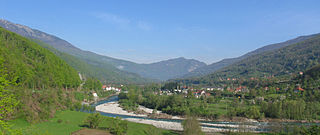 W
WThe Principality of Montenegro was a former realm in Southeastern Europe that existed from 13 March 1852 to 28 August 1910. It was then proclaimed a kingdom by Nikola I, who then became king.
 W
WThe Battle of Grahovac took place in the eponymous village of Grahovac from 29 April to 1 May 1858, when Montenegrin Grand Duke Mirko Petrović-Njegoš led the army of Principality of Montenegro against the Ottomans, ending in a decisive Montenegrin victory. After the victory, the demarcation of the border between Montenegro and the Ottoman Bosnia Eyalet was finalised. A considerable arsenal of war trophies was captured following the retreat of the Ottoman army.
 W
WThe Battle of Vučji Do was a major battle that took place on 18 July 1876 in Vučji Do, Sanjak of Herzegovina, fought between the combined forces of Montenegrin and Eastern Herzegovinian tribes (battalions) against the Ottoman Army under Grand Vizier Ahmed Muhtar Pasha. The Montenegrin-Herzegovinian forces heavily defeated the Ottomans, and managed to capture two of their commanders. In addition, they captured a large consignment of armament.
 W
WThe Battles for Plav and Gusinje were armed conflicts between the Principality of Montenegro and Ottoman irregular armies that broke out following the decision of the Congress of Berlin (1878) that the territories of Plav and Gusinje be ceded to Montenegro. The conflicts took place in this territory between 9 October 1879 and 8 January 1880. The following battles were fought:Velika attacks, Montenegrin victory Battle of Novšiće, Ottoman irregular victory Battle of Murino, Montenegrin victory
 W
WGrahovo is a historical Montenegrin clan and settlement in the Nikšić municipality of southwestern Montenegro.
 W
WLješanska nahija is a historical region in eastern Montenegro. It was a nahija (sub-district) of the Ottoman Empire. In the administration of the Principality of Montenegro, the nahija was part of Old Montenegro, alongside Katun, Rijeka and Crmnica. The Gradac Monastery is located within the region.
 W
WOn the third day of Serbian Christmas, January 8, 1880, about a month after the battle of Novšiće, around 10,000 pro-Ottoman Albanians attacked the Montenegrin forces numbering 3,000, led by commanders Marko Miljanov and Todor Miljanov and priest Đoko, in Murino. At this battle, the Montenegrin forces were made up of the Bratonožići, Vasojevići and Moračani. The Albanians, among whom were Ottoman regulars, had 1,400 casualties, the Montenegrins 36 dead and 70 wounded.
 W
WThe Battle of Novšiće ) was a battle for control over Plav and Gusinje fought on 4 December 1879 between the forces of Principality of Montenegro led by Marko Miljanov and local pro-Ottoman forces which included irregulars of the League of Prizren, both commanded by Ali Pasha, the Kaymekam of Gusinje. The League of Prizren consisted of the local Albanians and Bosniaks from Plav and Gusinje in Scutari Vilayet and irregulars from Kosovo Vilayet. Some of them where Muslims of Montenegrin origin like Husein Bektešević.
 W
WOld Montenegro, also known as Montenegro proper, or True Montenegro, is a term used for the embryonic part of modern Montenegro. In historical context, the term designates the original territory of the Principality of Montenegro, before the territorial expansion, ratified by the Congress of Berlin in 1878, or even more precisely - the territory of the Prince-Bishopric of Montenegro prior to its unification with the region of Brda in the first half of the 19th century.
 W
WThe People's Party, known as klubaši or narodnjaci, was a political party formed in 1906, active in the Principality of Montenegro and later Kingdom of Montenegro, led by Šako Petrović, which represented the opposition to Prince/King Nikola of Montenegro. The parties political credo was the unification of Montenegro and Serbia, and dethroning of the Petrović-Njegoš dynasty.
 W
WPetrović-Njegoš were the family that ruled Montenegro from 1696 to 1916. Montenegro had enjoyed de facto independence from the Ottoman Empire since 1711, but it only received formal international recognition as an independent principality in 1878.
 W
WThe Principality of Montenegro was a former realm in Southeastern Europe that existed from 13 March 1852 to 28 August 1910. It was then proclaimed a kingdom by Nikola I, who then became king.
 W
WDuring the implementation of the Congress of Berlin, when the Principality of Montenegro had received Plav and Gusinje, the surrounding Albanian populace under the guise of the Ottomans attacked the Montenegrin forces in Velika at two occasions, on October 9 and November 22, 1879. The Ottomans were defeated.